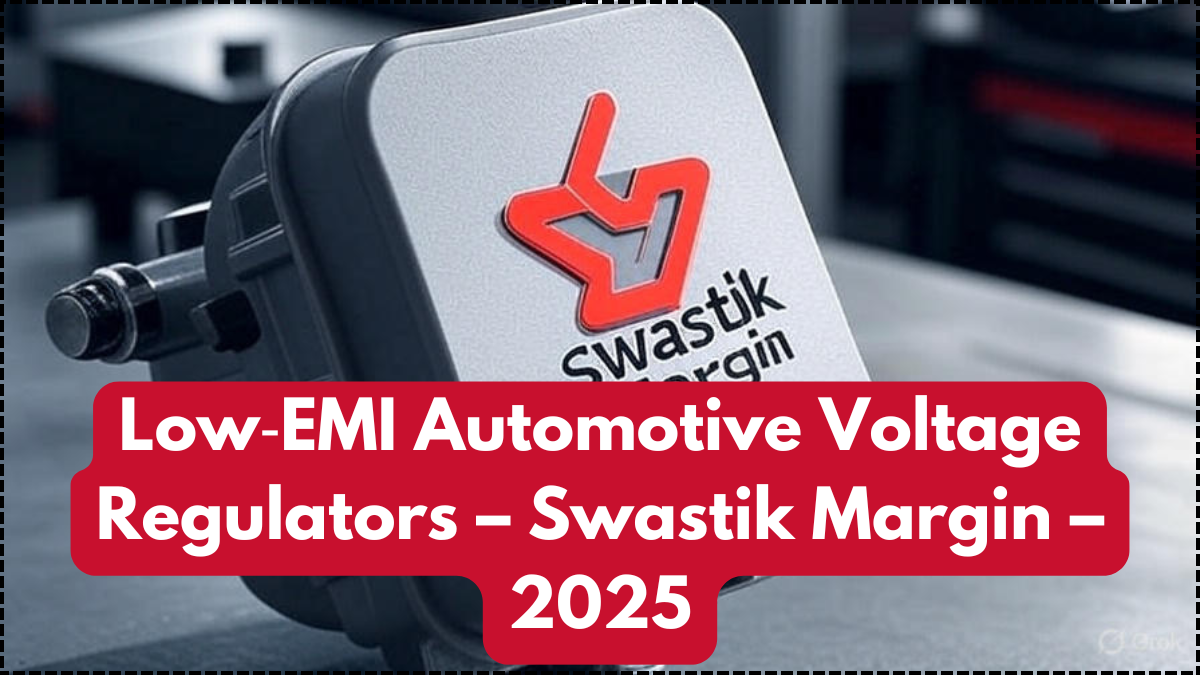The push toward more sophisticated electronic systems in vehicles demands cleaner power delivery. With vehicles increasingly reliant on ECUs, sensors, infotainment units, and autonomous technologies, interference-free operation is critical. This is where automotive EMI regulator circuits come into play—ensuring stable power delivery without compromising signal integrity.
In 2025, Swastik has positioned itself as a market leader with its new line of low-EMI voltage regulators, built specifically for high-performance, low-noise applications in vehicles. These regulators are not just conventional power tools—they are engineered with EMI filters and shielding technology to meet the automotive industry’s strictest electromagnetic compatibility standards.
Swastik’s advanced voltage regulation systems are helping OEMs build vehicles that operate seamlessly across multiple electrical and digital subsystems.

Why Low-EMI Voltage Regulation Is Crucial for Vehicles
In any vehicle, especially EVs and connected cars, a clean power supply is vital. If a voltage regulator emits too much electromagnetic interference, it can disrupt the operation of sensitive systems such as GPS, ADAS, camera modules, and wireless connectivity.
Automotive EMI regulator circuits by Swastik solve this by combining precision voltage control with embedded EMI filters that block unwanted noise. These components are essential for:
-
Autonomous driving modules
-
Advanced driver-assistance systems (ADAS)
-
In-vehicle connectivity platforms (Bluetooth, Wi-Fi)
-
Battery management systems (BMS)
Without proper EMI control, modern voltage regulators could become the root cause of malfunction or interference in critical safety or navigation systems. Swastik’s solutions are built to avoid this risk altogether.
Product Highlights: Swastik’s Low-EMI Regulator Range
Swastik’s product range for 2025 focuses on high-efficiency, compact design and minimal radiated noise. The regulators are versatile enough to support both high-voltage and low-voltage segments across multiple vehicle platforms.
| Regulator Model | Input Voltage | Output Voltage | EMI Filtering | Key Applications |
|---|---|---|---|---|
| VRX-5L | 5V–36V | 3.3V/5V | Integrated | Dashboards, sensors, infotainment |
| VRX-12F | 12V–48V | 5V/12V | External Cap | ADAS systems, camera modules |
| VRX-24Q | 24V–60V | Configurable | Enhanced EMI | BMS, EV motor controllers |
| VRX-48X | 36V–80V | 3.3V/5V/12V | Dual-Stage | Automotive telematics, ECUs |
Each of these automotive EMI regulator circuits features advanced shielding and noise suppression capabilities. They meet ISO 7637-2 and CISPR 25 standards, ensuring they can be safely installed near sensitive electronics without causing performance issues.
Built for Harsh Conditions and Long-Term Use
Swastik’s voltage regulators are not only designed for low noise—they’re also made for durability in real-world automotive environments. The regulators are AEC-Q100 qualified, vibration-resistant, and thermally protected to handle wide temperature variations from -40°C to 125°C.
Key durability features include:
-
Conformal-coated PCBs for moisture resistance
-
Fault-tolerant circuitry to handle voltage spikes
-
Low standby current for battery conservation
-
Compact surface-mount design for easy installation
These features make Swastik’s EMI filters and regulators ideal for electric cars, commercial vehicles, and hybrid platforms operating in rugged or unpredictable terrain.
Future-Ready Power Management for Modern Vehicles
As automotive technology evolves, the integration of autonomous sensors, 5G modules, and radar systems has amplified the need for low-noise power delivery. Swastik’s 2025 voltage regulators are future-ready, designed to seamlessly fit into modular vehicle architectures.
What’s more, Swastik offers programmable regulators that can be tuned for specific output voltages and EMI thresholds. This adaptability allows OEMs to reduce component clutter and design more compact, efficient power systems.
With real-time thermal feedback, programmable soft-start, and fault alerts, Swastik’s automotive EMI regulator circuits offer both protection and precision. They are part of a broader strategy to make vehicles more connected, autonomous, and electronically robust.
Conclusion: Swastik’s Low-EMI Leadership in 2025
The automotive industry’s shift to smart and electric platforms has created an urgent need for stable, clean, and EMI-compliant power sources. Swastik has met that demand by delivering a class-leading line of voltage regulators that combine durability with high-performance EMI suppression.
Through precise engineering, compliance with global standards, and integration flexibility, Swastik is helping OEMs and Tier 1 suppliers power the next generation of connected mobility. Their automotive EMI regulator circuits stand as proof that efficient voltage control and low electromagnetic interference can—and must—go hand in hand.
Swastik’s 2025 offering is not just a product update—it is a foundation for a cleaner, safer, and more interference-free automotive future.
FAQs
What are automotive EMI regulator circuits?
They are voltage regulators designed to supply stable power to vehicle electronics while minimizing electromagnetic interference, ensuring safe operation of sensitive components.
Why is EMI suppression important in modern vehicles?
EMI can disrupt critical systems like GPS, wireless modules, and ADAS. Proper EMI filtering prevents communication failures or sensor glitches in safety-critical applications.
What makes Swastik’s regulators unique?
Swastik integrates EMI filters directly into the voltage regulator circuits, ensuring low noise output and compliance with automotive standards like CISPR 25.
Can these regulators be used in electric vehicles?
Yes, Swastik’s low-EMI voltage regulators are built for both EV and ICE vehicles, supporting high voltages, modular installations, and multi-system integration.
Are Swastik’s voltage regulators industry-certified?
Absolutely. All products are AEC-Q100 qualified and tested for ISO 7637-2 compliance, ensuring safe performance in real-world automotive conditions.
Click here to know more